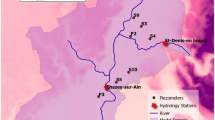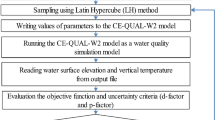Abstract
Large scaled simulation models, especially the water quality simulation models, are so complicated that makes calibration processes huge tasks; in order to attain optimum solution, lots of parameters must be calibrated, simultaneously. Methods based on evolutionary algorithm developed new horizons in calibration procedure. Hybrid algorithms are of the newest. In hybrid algorithms, one of the modules is applied as a simulator and the other one takes role as an optimization module. In this article, overcoming these challenges, hybrid ANN-PSO algorithm is applied in calibration process of water quality model CE-QUAL-W2. Here, Particle Swarm Optimization (PSO) provides simulation (CE-QUAL-W2) model with sets of parameters to simulate model. Using these results, Neural Network (estimator) is trained. In the next step, simulator would be replaced with estimator and Artificial Neural Network (ANN) would estimate simulator’s behavior in a way less time. The first goal is to calibrate thermal parameter; going forward through this process needs water surface elevation parameter to be calibrated, too. As a result, the proposed model will become multi-objective one, applied in Karkheh reservoir in Iran during 6 month simulation period. The proposed approach overcomes the high computational efforts required if a conventional calibration search technique was used, while retaining the quality of the final calibration results. Estimator (ANN) embedded in optimization algorithm (PSO) in calibration process, undoubtedly, reduced run time while the answers have reliable quality.
Similar content being viewed by others
References
Afshar, A., Kazemi, H., and Saadatpour, M. (2011). “Particle swarm optimization for automatic calibration of large scale water quality model (CE-QUAL-W2); application to Karkheh Reservoir, Iran.” Journal of water resource management, Vol. 25, No. 10, pp. 2613–2632.
Afshar, A. and Saadatpour, M. (2009). “Reservoir eutrophication modelling, sensitivity analysis, and assessment; application to Karkheh Reservoir, Iran.” Journal of Env. Eng. Sci, Vol. 26, No. 7, pp. 1227–1238.
Baker, T. and Dycus, D. (2004). “Use of monitoring information to identify and implement water quality improvement.” National Monitoring Conference, Chattanooga, TN, pp. 17–20.
Chau, K., (2005). “A split-step PSO algorithm in prediction of water quality pollution.” Lecture Notes in Computer Science, Springer-Verlag Berlin, No. 3498, p. 982.
Cheng, C. T., Ou, C. P., and Chau, K. W. (2002). “Combining a fuzzy optimal model with a genetic algorithm to solve multiobjective rainfall-runoff model calibration.” Journal of Hydrology, Vol. 268, Nos. 1–4, pp. 72–86.
Chung, S. W. and Oh, J. K. (2006). “Calibration of CE-QUAL-W2 for a monomictic reservoir in a monsoon climate area.” Water Sci. Technol., Vol. 54, Nos. 11–12, pp. 29–37.
Cole, T. M. and Wells, S. A. (2000). CE-QUAL-W2: A two-dimensional, laterally averaged, hydrodynamic and water quality model, version 3.2 user manual, U.S. Army Corps of Engineers Washington, D.C., 20314–1000.
Diogo, P. A., Fonseca, M., Coelho, P. S., Mateus, N. S., Almeida, M. C., and Rodrigues, A. C. (2008). “Reservoir phosphorous sources evaluation and water quality modeling in a transboundary watershed.” Desalination, Vol. 226, Issues 1–3, pp. 200–214.
Finley, J. R., Pintér, J. D., and Satish, M. G. (1998). “Automatic model calibration applying global optimization techniques.” Environmental Modeling and Assessment, Vol. 3, Nos. 1–2, pp. 117–126.
Gelda, R. K. and Effler, S. W. (2007). “Testing and application of a twodimensional hydrothermal model for a water supply reservoir: Implication of sedimentation.” Env. Eng. Sci, Vol. 6, No. 1, pp. 73–84.
Goktas, R. K., Aksoy, A., and A. M. ASCE (2007). “Calibration and verification of QUAL2E using genetic algorithm optimization.” Journal of Water Resources Planning and Management, Vol. 133, No. 2, pp. 126–136.
Huang, Y. (2008). “Automatic calibration of a surface water quality model using a hybrid genetic algorithm.” IEEE, The 2nd International Conference on Bioinformatics and Biomedical Engineering, pp. 3629–3632.
Kazemi, H. (2010). Calibration of large scale water quality model (CEQUAL-W2) by hybrid algorithm, MSc Thesis, Iran University of Science and Technology.
Kumar, D. N. and Reddy, M. J. (2007). “Multipurpose reservoir operation using particle swarm optimization.” Water Resou. Plan. Manag., Vol. 133, No. 3, pp. 192–201.
Kuo, J. T., Lung, W. S., Yang, C. P., Liu, W. C., Yang, M. D., and Tang, T. S. (2006). “Eutrophication modelling of reservoirs in Taiwan.” Env. Modelling & Software, Vol. 21, No. 6, pp. 829–844.
Kuo, J. T., Wang, Y. Y, and Lung, W. S. (2006), “A hybrid neural-genetic algorithm for reservoir water quality management.” Water Res., Vol. 40, No. 7, pp. 1367–1376.
Liu, W. C., Chen, W. B., and Kimura, N. (2009). “Impact of phosphorus load reduction on water quality in a stratified reservoir-eutrophication modeling study.” Environ Monit Assess, Vol. 159, Nos. 1–4, pp. 393–406.
Lu, W. Z., Fan, H. Y., Leung, A.Y. T., and Wong, J. C. K. (2002). “Analysis of pollutant levels in central Hong Kong, applying neural network method with particle swarm optimization.” Env. Monitor. Assess. Vol. 79, No. 3, pp. 217–230.
Meraji, S. H. (2004). Optimum design of flood control systems by particle swarm optimization algorithm, MSc Thesis, Iran University of Science and Technology.
Mohamadi, H. (2002). Two dimentional reservoir eutrophication modelling, MSc Thesis, Iran University of Science and Technology.
Mulligan, A. and Brown, L. (1998), “Genetic algorithms for calibration water quality models.” Journal of Environmental Engineering, Vol. 124, No. 3, pp. 202–211.
Muttil, N. and Chau, K. W. (2006). “Neural network and genetic programming for modelling coastal algal blooms.” International Journal of Environment and Pollution, Vol. 28, Nos. 3–4, pp. 223–238.
Nazif, S., Karamouz, M., Tabesh, M., and Moridi, A. (2010). “Pressure management model for urban water distribution networks.” Water Resour Manage, Vol. 24, No. 3, pp. 437–458.
Nielsen, E. J. (2005). Algal succession and nutrient dynamics in elephant butte reservoir, MSc Thesis, Brigham Young University.
Ng, A. W. M. and Perera, B. J. C. (2003). “Selection of genetic algorithm operators for river water quality model calibration.” Engineering Applications of Artificial Intelligence, Vol. 16, Nos. 5–6, pp. 529–541.
Ostfeld, A. and Salomons, S. H. (2005). “A hybrid genetic-instance based learning algorithm for CE-QUAL-W2 calibration.” Journal of Hydrology, Vol. 310, Nos. 1–4, pp. 122–142.
Poeter, E. P. and Hill, M. C. (1997). “Inverse models: A necessary next step in ground-water modeling.” Ground water, Vol. 35, No. 2, pp. 250–260.
Pelletier, G. J., Chapra, S., and Tao, H. (2006). “QUAL2Kw e A framework for modeling water quality in streams and rivers using a genetic algorithm for calibration.” Environmental Modelling & Software, Vol. 21, No. 05-03-044, pp. 419–425.
Shen, J. and Kuo, A. Y. (1998). “Application of inverse method to calibrate estuarine eutrophication model.” Journal of Environmental Engineering, Vol. 124, No. 8, pp. 1031–1040.
Shourian, M., Mousavi, S. J., and Tahershamsi, A. (2008). “Basin-wide water resources planning by integrating PSO algorithm and MODSIM.” Water Resour. Manage., Vol. 22, No. 10, pp. 1347–1366.
Sullivan, A. B. and Round, S. A. (2005). Modeling hydrodynamics, temperature, and water quality in henry hagg lake, Scientific Investigations Report, pp. 2004–5261.
Author information
Authors and Affiliations
Corresponding author
Rights and permissions
About this article
Cite this article
Afshar, A., Kazemi, H. Multi objective calibration of large scaled water quality model using a hybrid particle swarm optimization and neural network algorithm. KSCE J Civ Eng 16, 913–918 (2012). https://doi.org/10.1007/s12205-012-1438-3
Received:
Revised:
Accepted:
Published:
Issue Date:
DOI: https://doi.org/10.1007/s12205-012-1438-3




